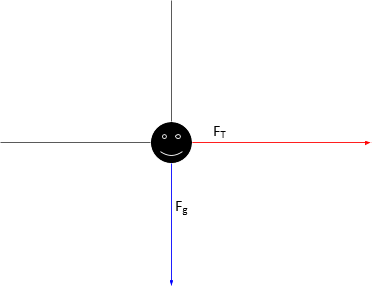Collaborator
Objective
The objective of this experiment is to swing a mass over one’s head and figure out what the tension in the string is based on the mass of the mass and period of its rotation.
Materials
PocketLab One
String
Ruler
A mass
Cowboy hats (optional but highly encouraged)
Stopwatch
Introduction
Kenneth, Rohit and Erfan grew up watching western movies, but being children of Eastern descent, one can easily infer the complications associated with their dreams to be cowboys. Additionally, having grown up in the 21st century, there are much cooler and arguably easier jobs to be had, such as being a writer.
To understand the forces at play, check out this free-body diagram of the swinging mass

Where Fg is the force due to gravity and FT is the tensile force from the string on the mass
We can isolate FT with this formula:

where r is the length of the string between the test subject’s hand and the mass, m is the mass of the object, and T is the period of the rotation.
Check out this link to see how we derived this formula.
To get a consistent period, we can swing the mass to the beat of our favourite songs. We’d pick anything with a tempo between moderato and allegro (100 – 150 bpm). See table for some recommendations.
| Song | Tempo (bpm) | Period (s) |
| Moanin’ – Art Blakey | 120 | 0.5 |
| Die MF Die – Dope | 130 | 0.462 |
| Girl From Ipanema (Getz version) | 130 | 0.462 |
| Arise – Flyleaf | 140 | 0.429 |
| Dark Thoughts – Josh A | 160 | 0.375 |
| Work Song – Nat Adderley | 160 | 0.375 |
| From a Cage – Envoi | 170 | 0.353 |
| Ocean Avenue – Yellowcard | 175 | 0.343 |
| KARATE – BABYMETAL | 180 | 0.333 |
| Theme from Black Orpheus (Paul Desmond version) | 190 | 0.316 |
| Giant Steps – John Coltrane | 300 | 0.2 |
Procedure
- Record the mass of the mass and the PocketLab
- Measure a length of a string, and attach it to the pocketlab.
- Put on your cowboy hat
- Have a partner record the amount of time it takes for the mass to complete a full circle around you. This is the period of the revolution. To reduce error, count ten revolutions and divide the recorded time by ten.
- Repeat Step 4 ten more times to determine a mean period and the standard deviation. These will be used to determine the tensile force in the string.
- Time permitting, try different lengths of string, or swing the mass faster or slower.
Neat Variation
Rather than swinging the mass in a circle parallel to the ground, we could try swinging the mass perpendicular to the ground (a yoyo trick entitled “around the world”) and see how the tension changes at different parts of the orbit.
Leave a Reply